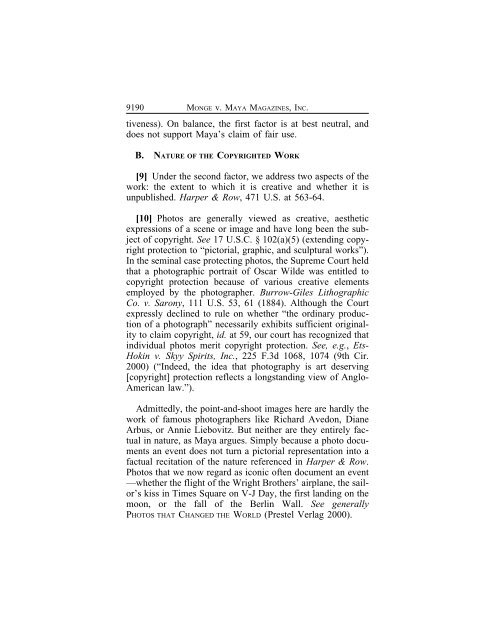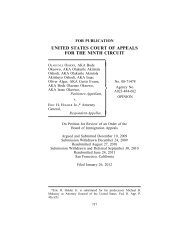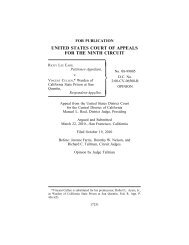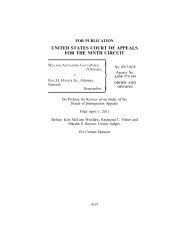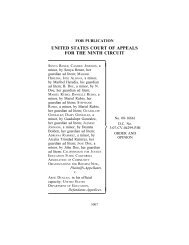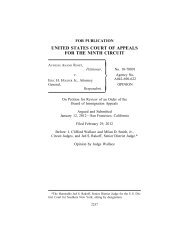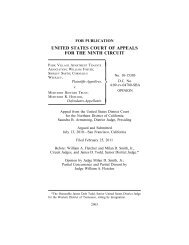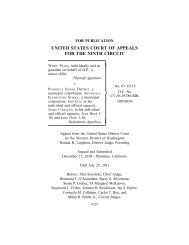NOELIA MONGE V. MAYA MAGAZINES, INC. - Ninth Circuit Court of ...
NOELIA MONGE V. MAYA MAGAZINES, INC. - Ninth Circuit Court of ...
NOELIA MONGE V. MAYA MAGAZINES, INC. - Ninth Circuit Court of ...
You also want an ePaper? Increase the reach of your titles
YUMPU automatically turns print PDFs into web optimized ePapers that Google loves.
9190 <strong>MONGE</strong> v. <strong>MAYA</strong> <strong>MAGAZINES</strong>, <strong>INC</strong>.<br />
tiveness). On balance, the first factor is at best neutral, and<br />
does not support Maya’s claim <strong>of</strong> fair use.<br />
B. NATURE OF THE COPYRIGHTED WORK<br />
[9] Under the second factor, we address two aspects <strong>of</strong> the<br />
work: the extent to which it is creative and whether it is<br />
unpublished. Harper & Row, 471 U.S. at 563-64.<br />
[10] Photos are generally viewed as creative, aesthetic<br />
expressions <strong>of</strong> a scene or image and have long been the subject<br />
<strong>of</strong> copyright. See 17 U.S.C. § 102(a)(5) (extending copyright<br />
protection to “pictorial, graphic, and sculptural works”).<br />
In the seminal case protecting photos, the Supreme <strong>Court</strong> held<br />
that a photographic portrait <strong>of</strong> Oscar Wilde was entitled to<br />
copyright protection because <strong>of</strong> various creative elements<br />
employed by the photographer. Burrow-Giles Lithographic<br />
Co. v. Sarony, 111 U.S. 53, 61 (1884). Although the <strong>Court</strong><br />
expressly declined to rule on whether “the ordinary production<br />
<strong>of</strong> a photograph” necessarily exhibits sufficient originality<br />
to claim copyright, id. at 59, our court has recognized that<br />
individual photos merit copyright protection. See, e.g., Ets-<br />
Hokin v. Skyy Spirits, Inc., 225 F.3d 1068, 1074 (9th Cir.<br />
2000) (“Indeed, the idea that photography is art deserving<br />
[copyright] protection reflects a longstanding view <strong>of</strong> Anglo-<br />
American law.”).<br />
Admittedly, the point-and-shoot images here are hardly the<br />
work <strong>of</strong> famous photographers like Richard Avedon, Diane<br />
Arbus, or Annie Liebovitz. But neither are they entirely factual<br />
in nature, as Maya argues. Simply because a photo documents<br />
an event does not turn a pictorial representation into a<br />
factual recitation <strong>of</strong> the nature referenced in Harper & Row.<br />
Photos that we now regard as iconic <strong>of</strong>ten document an event<br />
—whether the flight <strong>of</strong> the Wright Brothers’ airplane, the sailor’s<br />
kiss in Times Square on V-J Day, the first landing on the<br />
moon, or the fall <strong>of</strong> the Berlin Wall. See generally<br />
PHOTOS THAT CHANGED THE WORLD (Prestel Verlag 2000).


